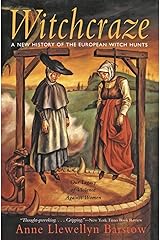Chapter One is titled, "Why Women?" How would you answer that question after reading the chapter? Ask the 'cui bono' question...who benefits? How does Barstow explain the structure of the witch hunt? Chapters three and four look at different geographies. Did place (local context) matter? If so, how?
The answer to the question of “why women?” is both simple and too complex for me to explain successfully. The simple answer is that women were on the margins of early modern European culture. Though society had not always been so unapologetically patriarchal and punitive, sixteenth century European women were quickly becoming the low-hanging fruit, so to speak. And they were all the easier to ‘pick-off’ if they lacked a male who might intervene on their behalf. As Barstow explains, women were all “marginal by gender, and many were marginal in other ways, so marginal that no one would avenge them.” (Barstow, 153).
So, superficially, the answer is that the male authorities (religious and secular) did it because they could (much the same as what they did in colonizing other people’s lands and trading human beings like commodities). They felt entitled, and by violence and psychological terror tactics they got away with all of it. But the questions about why they felt entitled, what satisfaction the process gave them, and why they even felt the need to do it; veer into the complicated territory of the answer. Trying to explain the need for a scapegoat/sacrifice in the first place, the projection of dangerous sexuality onto women who were at the complete mercy of men engaged in a public orgy of sadism, and the ingrained fear of the imagined secret power of the least powerful people in the society, are all areas where the book takes deep and interesting dives, but words still fail me.
The structure of the witch hunt, even in places like England where blatant physical torture was not permitted and where “witchcraft was seen, not as heresy, but as straightforward criminality” (Barstow, 75), was never a fair undertaking. And wherever they were held geographically, there was the disturbing conflict of interest wherein either the accuser or those judging the accused would often inherit the ‘witch’s’ property upon her conviction/death. Explaining, perhaps, how so many of the ‘witches’ were single/widowed women with no male relative waiting to inherit from them, or how such male relatives ended up at an adjacent stake.
But geography did matter greatly in terms of how the ‘trials’ were run, and the punishments administered. Inquisitional norms like secret sessions, secret accusers, denial of counsel, allowing prejudiced sources, not allowing cross-examination and worst of all, the wildly prejudicial assumption of guilt (Barstow, 49) where rampant on the continent. Oddly, the actual Inquisitions of Italy and Spain were less bloodthirsty when administering punishments than the various courts of the southern regions of Germany - where women as ‘witches’ seem to have replaced the dwindling supply of Jewish scapegoats who had been persecuted since 1095 (Barstow, 62).
Wherever the ‘trial’ was taking place the basic structure of it
was always stacked against the woman being charged. European women, who were not
permitted higher education (Barstow, 147), had previously been thought of,
legally, “as minors” to be “kept in line” by a male family member (Barstow,
40). In fact, women only “emerged into full legal adulthood as witches”
– their “independent legal status” was given to them “in order to be prosecuted
for witchcraft” without dragging the menfolk into court (Barstow, 41). Once
accused, “[w]omen found themselves alone.” Families either abandoned them or
actively turned against them. Accused by neighbors and people they had once
considered friends. They were on their own to deal with “legal procedures they
did not understand” (Barstow, 148). But fairness was never the goal, and
unsurprisingly, once accused, there was very little hope of being found
innocent.
If interested in purchasing this book, here's a link to it on Amazon
full disclosure: it's an affiliate link - costs you nothing extra but sends me a few pennies for recommending something I like







Comments
Post a Comment